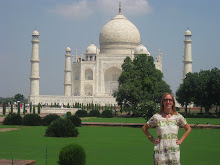On June 5th, I sat down with Brendan Kealey to get some advice on getting myself ready for my trip. Brendan had just spent three months on behalf of Pearson mostly in Mumbai (Bombay), but he also visited Delhi.
"You scared me," he said, after I had the woman at the front desk buzz his desk in our North Dodge office. Apparently, the week before, he had a surprise visit from one of his colleagues in India. "Come see me in the United States," he'd said, figuring he would get a phone call or email announcing any such visit. But this was not the case.
All the factoids I'd read in the guidebooks fluttered through my mind. Indians don't say no because they don't like conflict. They wobble their heads from side to side instead of up and down to signify agreement. Don't ever eat from street vendors. Was any of this true? It’s one thing to read a guidebook and another to hear from a person who’s just experienced the culture.
Right now, everything India is conceptual to me. I am building a picture of this country in my head, checking and comparing sources to affirm or deny the façade I’m creating. Yet I still know my India is nothing more than a series of ideas. I read a book. I visit the Travel Clinic. I email back and forth with a few people who have been or are there.
So how’s my surreal India, Brendan? How close am I getting?
So far, so good.
Brendan affirmed almost everything I'd read except for the part about taking medication with you. "You can get a stick of Cipro for, like, twenty five cents at any drugstore--without a prescription." He regretted going to the Travel Clinic, he said, and buying his prescriptions here for our comparatively exorbitant prices.
The Travel Clinic, I should add, was exorbitant and not covered by regular insurance. My series of shots and brief consultation will end up costing over a thousand dollars. I still wouldn’t have gone without it, though. I think Brendan may have a different perspective, being the son of a doctor.
Brendan also helped me make a few more adjustments to the India in my head. I thought everything would be relatively cheap, but this isn’t necessarily the case. “Labor is cheap; products are expensive,” he said. Case in point: he went to the local mall looking for a pair of jeans and found a Levis store. The jeans were pricey and, strangely, all came in one size: 36/36. When Brendan was exasperated from checking the size of every pair of jeans and finding them all this one strange size, he finally asked the man at the counter whether they had any other sizes anywhere. The man then pointed to a tailor who makes the jeans fit you after you buy them for a very low price.
Because the price of labor is so cheap, Brendan said that over-employment is common. There will be five people working on getting you one cup of coffee, he said: one to hold the door open, one to tell you welcome to the establishment, one to take your order, one to bring your coffee to you, and one to take your money.
I also assumed that everyone’s English would be rather good, but Brendan said this isn’t necessarily true. “If you get a driver with good English, try to hang onto him,” he advised. India is a country where English is everyone’s second language, not their first, he explained. So imagine everyone in America trying to use their high school Spanish to communicate. He said for many Indians, this is their level of proficiency; not so much in the multi-national business world, but in local contexts like restaurants, markets and taxis.
So I add these ideas to my sambar stew of impressions about this country on the other side of our planet. I tell myself I have some idea of what to expect; that I will not be totally overwhelmed; that my culture shock will be mitigated by my copious preparation. But I know that reading something and talking about it are not the same as walking through it. I know my India is still surreal; ideas floating in my head, however accurate or inaccurate they may be. I’ve read that the kaleidoscope of sound and smell and sight will throw any westerner off balance, and all I can really do is accept this and make sure the battery on my digital camera is fully charged.
Thanks to Brendan Kealey for his time and his stories.
Subscribe to:
Post Comments (Atom)


No comments:
Post a Comment